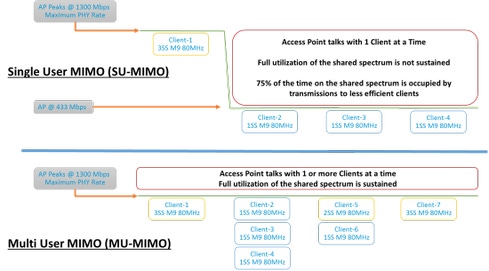In Houston, "Wave 2" wireless networking deployments are helping one community college revamp how students and faculty view education, especially with video.


7 Weird Wireless Concepts That Just Might Work
7 Weird Wireless Concepts That Just Might Work (Click image for larger view and slideshow.)
A modern university campus doesn't work without wireless networking. With the latest evolution in wireless standards -- 802.11ac "Wave 2," set to begin deployment this year -- network architects and admins at colleges and universities are looking forward to less congestion, better performance, and more innovative course offerings on wireless nets.
First-generation 802.11ac -- Wave 1 -- access points and devices are already in the field providing up to 1.3 Gbps speeds to devices. Wave 2 access points will deliver up to 2.34 Gbps speeds and they'll do something even more important for network administrators: They'll deliver those speeds to more than one device at a time.
Wave 1 access points are only able to connect at highest speed to one client at a time. SU-MIMO (Single-user Multiple Input/Multiple Output) uses multiple channels and frequencies at once in order to gain throughput speeds greater than that allowed over any single channel -- but to only one attached device at a time.
All the other devices connected to the access point will do so at reduced speeds comparable to 802.11n (433 Mbps or less). Wave 2 allows multiple clients to attach at the highest speeds through MU-MIMO (Multi-user MIMO) though the number of high-speed clients at any one time isn't infinite. Even so, network administrators at colleges and universities are beginning to plan for the expansion.
Kyle Cooper is Senior Network Architect at Houston Community College, a large community college system in Houston.
HCC serves about 115,000 students each year and has about 6,500 faculty and staff scattered across the Houston area in 26 campuses. In an interview with InformationWeek, he talked about why HCC is planning a Wave 2 deployment.
"Wireless is still reaching the catalyst moment where the promises that Wave 2 can bring will make the Achilles' heels of wireless less an issue," Cooper said. "In peak time the common areas and high-density areas receive so much traffic that the multi-user MIMO of Wave 2 lets us not over-provision the common areas quite so much."
As in so many organizations, one type of data is driving much of the demand for greater bandwidth at HCC. "In the classroom environment, the faculty has the need for more pervasive video use. This opens up the possibility to do more video interaction between student and faculty," Cooper said.
Renee Patton, Director of Education at Cisco, spoke with InformationWeek and said that Houston Community College's experience is not unique.
"Video is the big driver for bandwidth. When we talk to customers they're astounded by the video streams coming over their networks," Patton said during a telephone interview. "We're talking about lectures on the Web, but Netflix and gaming devices are driving huge bandwidth as well," Patton explained, saying, "They're often surprised because they plan on the educational stuff, but they're seeing students with their own requirements as well. They want the quality to be at least as good as what they're bringing from home."
[Want to know about another industry going mobile? Read Mobile Devices Replace Blueprints On Construction Sites. ]
One of the points made by both Cooper and Patton is that the number of attached devices, and the demand each places on the network, has grown much faster than the number of people in the user population.
"Students can be bringing seven or more devices from home and trying to connect each of them to the network. The sheer demand on the network can be huge," Patton said.
Cooper agreed with that analysis, adding, "When you talk about a collaborative classroom environment and you have 30 to 40 people in the classroom, all of them trying to stream video, it has a huge impact on the bandwidth to the room."
The advances in wireless networking do have implications for the rest of the networking infrastructure.
"We're standardizing so every AP location has two CAT6a cable drops," Cooper said. "We're planning on every Wave 2 AP needing 10 gig interconnects." Those cables will be carrying both data and power to many devices -- electrical power at a higher wattage than many other PoE devices and 10 Gigabits per second of data at distances of up to 100 meters. Patton acknowledged that, saying, "Wave 2 does have increased power requirements, but we're dealing with that and it can use the same cables."
Education is far from the only market to be waiting for Wave 2 082.11ac.
It is, however, the market that may sit most precisely at the intersection of high user density and consistent quality requirements. Kyle Cooper succinctly explained why it's important for network architects like him to get that intersection right. "We really need to get to a place where students and staff can use the network as a tool without it becoming an obstacle."
Attend Interop Las Vegas, the leading independent technology conference and expo series designed to inspire, inform, and connect the world's IT community. In 2015, look for all new programs, networking opportunities, and classes that will help you set your organization's IT action plan. It happens April 27 to May 1. Register with Discount Code MPOIWK for $200 off Total Access & Conference Passes.
About the Author(s)
You May Also Like







